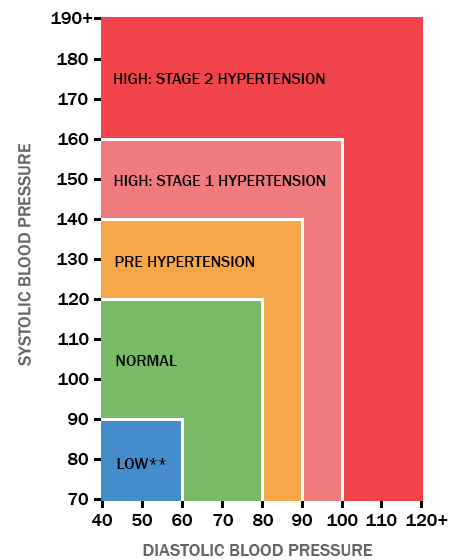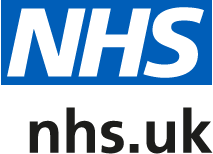Opening Times | Register | Contact Us
CQC Rating Good
Blood Pressure Calculator
Introduction
A blood pressure test is a simple way of checking if your blood pressure is too high or too low.
Blood pressure is the term used to describe the strength with which your blood pushes on the sides of your arteries as it's pumped around your body.
Blood Pressure Chart

High blood pressure (hypertension) can put a strain on your arteries and organs, which can increase your risk of developing serious problems such as heart attacks and strokes.
Low blood pressure (hypotension) isn't usually as serious, although it can cause dizziness and fainting in some people.
A blood pressure test is the only way to find out if your blood pressure is too high or too low, because most people won't have any obvious symptoms. Having a test is easy and could save your life.
Calculate Your Average Blood Pressure
When should I get my blood pressure tested?
You can ask for a blood pressure test if you're worried about your blood pressure at any point.
You can get your blood pressure tested at a number of places, including:
- at your local GP surgery
- at some pharmacies
- in some workplaces
- at home (see home blood pressure testing below)
- at an NHS Health Check appointment offered to adults in England aged 40-74
It's recommended that all adults over 40 years of age have their blood pressure tested at least every five years so any potential problems can be detected early.
If you've already been diagnosed with high or low blood pressure, or you're at a particularly high risk of these problems, you may need to have more frequent tests to monitor your blood pressure.
How blood pressure is tested
A device called a sphygmomanometer will be used to measure your blood pressure.
This usually consists of a stethoscope, arm cuff, pump and dial, although automatic devices that use sensors and have a digital display are also commonly used nowadays.
It's best to sit down with your back supported and legs uncrossed for the test. You'll usually need to roll up your sleeves or remove any long-sleeved clothing, so the cuff can be placed around your upper arm. Try to relax and avoid talking while the test is carried out.
During the test:
- you hold out one of your arms so it's at the same level as your heart, and the cuff is placed around it – your arm should be supported in this position, such as with a cushion or arm of a chair
- the cuff is pumped up to restrict the blood flow in your arm – this squeezing may feel a bit uncomfortable, but only lasts a few seconds
- the pressure in the cuff is slowly released while a stethoscope is used to listen to your pulse (digital devices use sensors to detect vibrations in your arteries)
- the pressure in the cuff is recorded at two points as the blood flow starts to return to your arm – these measurements are used to give your blood pressure reading (see below)
You can usually find out your result straight away, either from the healthcare professional carrying out the test or on the digital display.
Home blood pressure monitoring
Blood pressure tests can also be carried out at home using your own digital blood pressure monitor.
This can give a better reflection of your blood pressure, as being tested in somewhere like a GP surgery can make you feel anxious and can affect the result. It can also allow you to monitor your condition more easily in the long term.
You can buy a variety of low-cost monitors so you can test your blood pressure at home or while you're out and about.
It's important to make sure you use equipment that has been properly tested. The British Hypertension Society (BHS) has information about validated blood pressure monitors that are available to buy.
Ambulatory blood pressure monitoring
In some cases, your doctor may recommend 24-hour or ambulatory blood pressure monitoring (ABPM).
This is where your blood pressure is tested automatically around every 30 minutes over a 24-hour period using a cuff attached to a portable device worn on your waist.
ABPM can help to give a clear picture of how your blood pressure changes over the course of a day.
You should continue with your normal daily activities during the test, although you must avoid getting the equipment wet.
Understanding your blood pressure reading
Blood pressure is measured in millimetres of mercury (mmHg) and is given as two figures:
- systolic pressure – the pressure when your heart pushes blood out
- diastolic pressure – the pressure when your heart rests between beats
For example, if your blood pressure is "140 over 90" or 140/90mmHg, it means you have a systolic pressure of 140mmHg and a diastolic pressure of 90mmHg.
As a general guide:
- normal blood pressure is considered to be between 90/60mmHg and 120/80mmHg
- high blood pressure is considered to be 140/90mmHg or higher
- low blood pressure is considered to be 90/60mmHg or lower
A blood pressure reading between 120/80mmHg and 140/90mmHg could mean you're at risk of developing high blood pressure if you don't take steps to keep your blood pressure under control.
Find out more about what your blood pressure result means.
Controlling your blood pressure
If your blood pressure is found to be too high or too low, your GP or the healthcare professional performing the test can advise you about ways to control it.
This may involve:
- adopting a healthy, balanced diet and restricting your salt intake
- getting regular exercise
- cutting down on alcohol
- losing weight
- stopping smoking
- taking medication, such as angiotensin-converting enzyme (ACE) inhibitors or calcium channel blockers
In some cases, you may be referred to a doctor such as a cardiologist (heart specialist) to discuss treatment options.
Read more about treating high blood pressure and treating low blood pressure.
Content Provided by:

INDEX - Self-Help Centre
Self Help Information
- Pharmacy First
- Health A-Z
- Live Well
- Choose Well
- Winter Health
- Stop Smoking Help
- Age Well
- Healthy Lifestyle
- In Times Of Bereavement
- Every Mind Matters
Health Checks
Update Clinical Record
Update your clinical record by sending us your latest information, such as height, weight, blood pressure, smoking status, alcohol consumption...
Who Do I See - Advice Checker
We use cookies to help provide you with the best possible online experience.
By using this site, you agree that we may store and access cookies on your device. Cookie policy.
Cookie settings.
Functional Cookies
Functional Cookies are enabled by default at all times so that we can save your preferences for cookie settings and ensure site works and delivers best experience.
3rd Party Cookies
This website uses Google Analytics to collect anonymous information such as the number of visitors to the site, and the most popular pages.
Keeping this cookie enabled helps us to improve our website.
